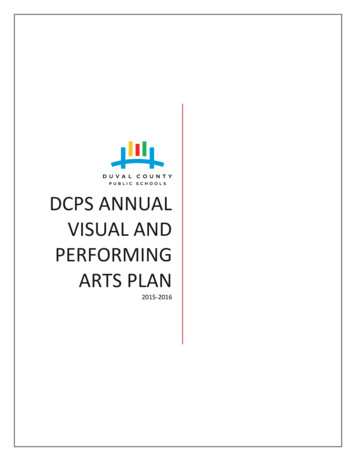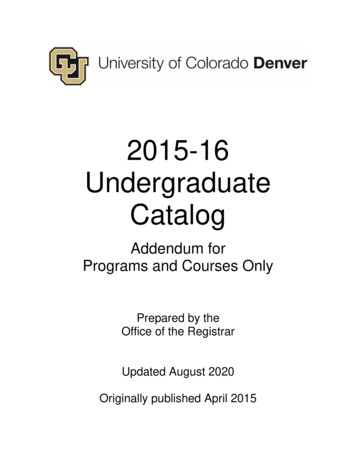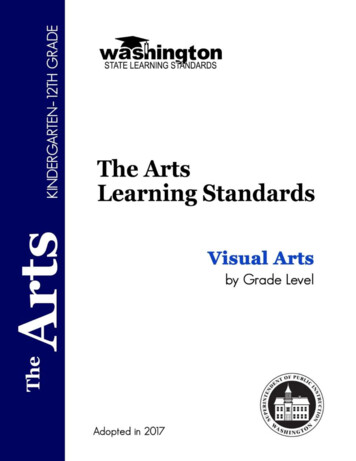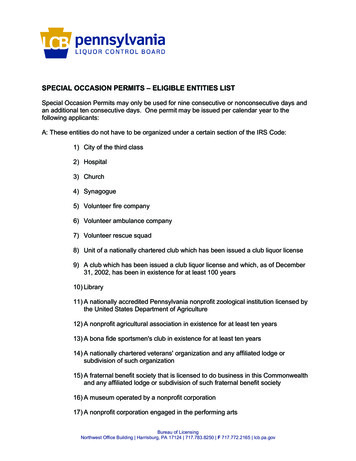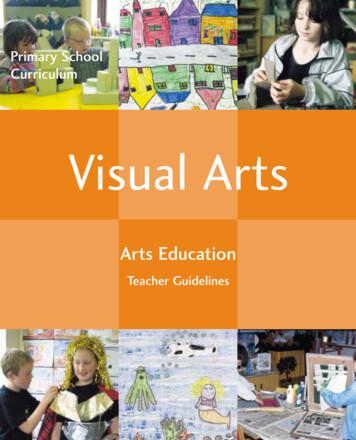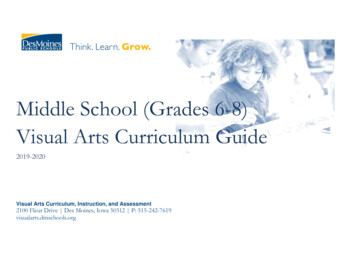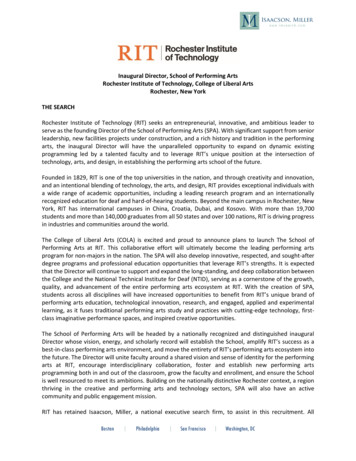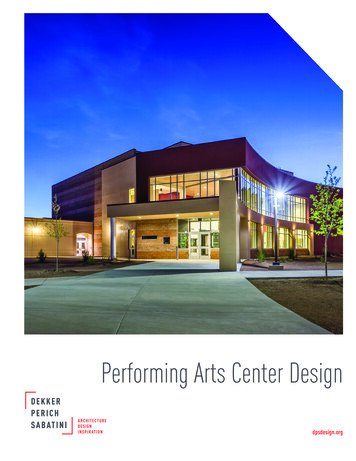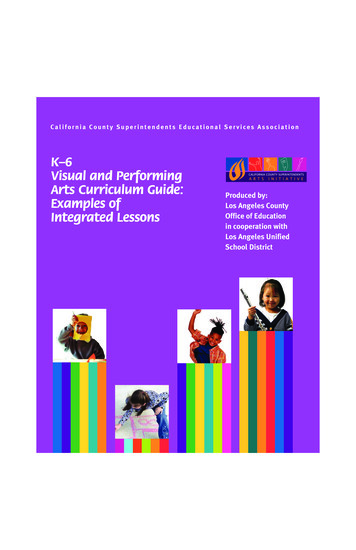
Transcription
BMJGPSOJB PVOUZ 4VQFSJOUFOEFOUT &EVDBUJPOBM 4FSWJDFT "TTPDJBUJPO K–6Visual and PerformingArts Curriculum Guide:Examples ofIntegrated Lessons1SPEVDFE CZ -PT "OHFMFT PVOUZ 0GGJDF PG &EVDBUJPO JO DPPQFSBUJPO XJUI -PT "OHFMFT 6OJGJFE 4DIPPM %JTUSJDU
i
ForewordOn behalf of the county superintendents of the State of California, we are pleased to introducethis K-6 Visual and Performing Arts Curriculum Guide: Examples of Integrated Lessonsdeveloped by the Los Angeles County Office of Education in partnership with the Los AngelesUnified School District as part of the (CCSESA) Arts Initiative and the Curriculum and InstructionSteering Committee (CISC) Visual and Performing Arts Subcommittee.The California County Superintendents Education Services Association (CCSESA) is anorganization consisting of the county superintendents of schools from the 58 counties inCalifornia working in partnership with the California Department of Education. The Curriculumand Instruction Steering Committee (CISC) is a subcommittee of CCSESA, consisting of countyoffice associate superintendents, focusing on curriculum, instruction, and professionaldevelopment. The Visual and Performing Arts (VAPA) Subcommittee includes regional artsleads representing all 11 service regions geared at strengthening support and service in artseducation to California school districts. Through the CCSESA Arts Initiative and the CISC VAPASubcommittee, county superintendents and their staffs are building capacity to advocate andincrease visibility for arts education in California public schools. One area of this work is in thedevelopment of K-12 arts education curriculum resources aligned to the Visual and PerformingArts Framework for California Public Schools.We appreciate the collaborative work and leadership of VAPA consultant for Los AngelesCounty Office of Education and Region 11 Arts Lead, Geraldine Walkup, and the LAUSD ArtsAdministrative Team of Richard Burrows, Director of LAUSD Arts Education Branch, and RobinLithgow, LAUSD Elementary Arts Coordinator. We also wish to acknowledge the expertiseand commitment of the writing team of teachers and arts specialists that contributed tothis document. And we extend special thanks to Patty Taylor, CCSESA Arts Consultant, whocontributed greatly to the development and finalization of the document as well as theCCSESA/CISC Visual and Performing Arts regional leads who provided input for this project.It is our hope that this will be a tool for schools and districts as they implement the Visualand Performing Arts Content Standards and gather evidence of student learning in the artsdisciplines of dance, music, theatre, and visual arts.Sarah AnderbergDirector, CCSESA Arts InitiativeCalifornia County Superintendents Educational Services AssociationFrancisca SanchezChair, Visual and Performing Arts SubcommitteeAssociate Superintendent, San Francisco Unified School Districtii
ContentsIntroduction . vAcknowledgments. viiGRADE/SUBJECTLESSON TITLEKINDERGARTENDance/English Language ArtsMusic/History-Social ScienceTheatre/MathVisual Arts/Science1“I Can Make Alphabet Shapes!” . 3“Sing When It’s Your Turn” . 6“Measuring Time and Change With TheVery Hungry Caterpillar” . 8“Plant Shapes: Showing the Diversity of Nature” .10GRADE 1Dance/ScienceMusic/English Language ArtsTheatre/History-Social ScienceVisual Arts/Math13“The Water Dance” . 15“Recite and Memorize With Rhyme, Rhythm and Melody” . 18“The Golden Rule and The Boy Who Cried Wolf”.20“Still Life Arrangement” .22GRADE 2Dance/English Language ArtsMusic/ScienceTheatre/MathVisual Arts/History-Social SciencePAGE25“Let’s Make a Sequence!” .27“Describing Pitch Through Movement and Comparison” .29“Problem-Solving in Measurement and Storytelling” .34“Color and Personality: How We ‘See’ History” .37GRADE 341Dance/MathMusic/Science“From Fractions to Rhythm” .42“What Does It Sound Like and Why:Exploring Musical Instruments” .45Theatre/English Language Arts“Discovering the 5 W’s With Nobiah’s Well” .47Visual Arts/History-Social Science “Geography of Landscapes” .50GRADE 4Dance/History-Social ScienceMusic/MathTheatre/English Language ArtsVisual Arts/Science53“Dancing Maps” . 55“Fractions and Music” . 59“Characters and the World in Relation” .63“Earth Moves” . 67GRADE 5Dance/ScienceMusic/English Language ArtsTheatre/History-Social ScienceVisual Arts/Math71“Circulation Dance” . 73“Music Can Communicate a Story” .76“The Causes of the Colonist Rebellion” .80“Illusion of Space” . 83GRADE 6Dance/MathMusic/History-Social ScienceTheatre/ScienceVisual Arts/English Language Arts87“Mathematical Reasoning and the Creative Process”.89“Mythology and the Music of Ancient Greece” .91“Theatre as a Tool in Environmental Activism”.97“Cultural Artifacts” .101References . 104Glossary . 105Blank Templates. 107Best Practice in Art Integration . 117iii
iv
Introduction“During the past quarter century, literally thousands of school-based programs have demonstrated beyond question that the arts can not only bring coherence to our fragmented world, butthrough the arts, students’ performance in other academic disciplines can be enhanced as well.”— Ernest L. Boy, President of the Carnegie Foundation for the Advancement of TeachingThe K-6 Visual and Performing Arts Curriculum Guide: Examples of Integrated Lessons wasdeveloped to provide elementary classroom teachers with a realistic and useful tool for creating arts integrated lessons. The connections made between disciplines are based on mutual concepts being taught. The guide includes standards-based lessons in dance, music, theatre, andvisual art, integrated with science, history-social science, math and language arts. The lessondesign is based on the principles of Understanding by Design by Grant Wiggins and Jay McTigue.Subjects and standards are chosen based on shared concepts or big ideas, from which essentialquestions are formed.Recently there have been a growing number of publications that address how to create andteach integrated lessons. They provide information on criteria for integration, approaches todeveloping lessons, models of integration, and oftentimes samples of the lessons themselves.One example of such literature is the Curriculum Resource Guide, which can be located atwww.ccsesaarts.org. Depending on the author and state of origin, a variety of terms are used torepresent the same idea. Therefore, it is necessary to identify the definition of integration thatguided that particular document. The authors of the K-6 Visual and Performing Arts Curriculum Guide: Examples of Integrated Lessons used the following definition of integration becauseequal attention is given to those subjects featured in the lessons.Arts Integration is instruction combining two or more contents, wherein the arts constitute one of the integrated areas. The integration is based on shared or related concepts,and instruction in each content area has depth and integrity reflected by embeddedassessments, standards, and objectives.—Southeast Center for Education in the Arts (SCEA), University of TennesseeIntegrated instructional design requires that lessons include an opening, teaching strategies,materials/resources, closure, and assessments. The lessons included in this guide provide additional strategies to strengthen the teacher’s delivery of the lesson and increase student learning. All the necessary components of a strong integrated lesson are included in the template.Please note that these lessons are not units of study and should be taught with this in mind.AssessmentIt is crucial that elementary teachers realize the importance of assessing students in the arts.The information gathered through ongoing assessment will inform the teacher of the level ofknowledge and skill his or her students have mastered and what topics need to be re-addressed.The guide includes a formative assessment at the end of each lesson in the form of open-endedquestions that teachers can use to easily assess the targeted standard. To access more information on arts assessments, please go to the CCSESA Arts Initiative Website at www.ccsesaarts.org.Click the Toolbox tab and you will find the Arts Assessment Guide developed by the San DiegoCounty Office of Education.An Unfinished Canvas: Arts Education in California:Taking Stock of Policies and PracticesA cluster of research studies sponsored by the William and Flora Hewlett Foundation and conducted by SRI International have addressed the many barriers that exist in offering sequentialstandards-based arts education to California students. The reports also point to many challenges in implementing visual and performing arts in California public schools, citing particularneeds at the elementary school level. To access the study, please go to www.hewlett.org to findcopies of the report.v
vi
AcknowledgmentsThe California County Superintendents Educational Services Association acknowledges thefollowing dedicated educators for their contribution to the K-6 Curriculum Guide.National ConsultantKaren L. Erickson, Director, Creative DirectionsConsultantsRichard Burrows, Director, Arts Education BranchLos Angeles Unified School DistrictRobin Lithgow, Elementary Arts CoordinatorLos Angeles Unified School DistrictGeraldine Walkup, Visual and Performing Arts ConsultantLos Angeles County Office of EducationLos Angeles Unified School District Writing TeamOlivia Armas, Elementary, Visual Arts TeacherSusan Marcena Massarak Aslan, Elementary, Classroom TeacherMegan Deakers, Elementary, Dance TeacherMelanie Dubose, Elementary, Classroom TeacherGinny Gaimari, Elementary, Theatre TeacherKaty Hickman, Elementary, Theatre TeacherAddie Lupert, Elementary, Music TeacherGinny Marrin, Elementary, Dance TeacherDenise Godinez Gonzalez, Elementary, Dance TeacherJuanda Marshall, Elementary, Music TeacherJulia Norstrand, Elementary, Theatre TeacherRosie Ochoa, Elementary, Dance TeacherEllen Robinson, Elementary, Visual Arts TeacherMargarita Vargas, Elementary, Classroom TeacherSonia Villegas, Elementary, Classroom TeacherRaissa White, Elementary, Theatre TeacherMary Whiteley, Elementary, Classroom TeacherLos Angeles Unified School District Arts SpecialistsJulie Corallo, Secondary, Music Content ExpertShana Habel, Elementary, Dance AdviserDr. Steven J. McCarthy, Elementary, Theatre SpecialistLuiz Sampaio, Elementary, Visual Arts SpecialistSteve Venz, Elementary, Music SpecialistGraphics/LayoutLACOE Communications/Graphics Unitvii
viii
Grade K Lessons1
2
Students will be able to make the shapes of the letters of thealphabet with their bodies using straight and curved lines.Were students able to make the “shapes” of the letters of thealphabet with their bodies using straight and curved lines?Student Objectives3MATERIALS/RESOURCES Able to recognize that lines make letter shapes Able to travel through space with control Able to recognize the alphabetLetters, alphabet, line, curved, straight, zigzag Lines form letters. Lines: Curved, straight, zigzag, horizontal and vertical Letter formation: uppercase and lowercase letters1.4 Write uppercase and lowercase letters of the alphabetindependently attending to the form and proper spacing ofthe letters.Students will be able to write and recognize the letters of thealphabet.Were students able to recognize and write (form) the letters ofthe alphabet?ELATITLE OF LESSONI Can Make Alphabet Shapes!INTEGRATED STUDENT OBJECTIVEStudents will be able to use lines to write letters ofthe alphabet, and create shapes with their bodies. Alphabet Movers by Teresa Benzwie Drum or music (Suggested Music: Eric Chappelle. Music for Creative Movement, Vol. I - IV) Pencils and paperNew SkillsPrerequisite SkillsSKILLS Basic physical control of the body Able to identify a type of line Able to utilize a pencil and paper Uses the body as a tool to create a variety of shapes Able to write letter formsShape, line, straight, curved, zigzag, travel, audience, freezeNew VocabularyNew Concepts Body Awareness Spatial Awareness: Personal Space Able to freeze their body Basic locomotor movements(e.g., walking, hopping, jumping, galloping) The body makes shapes using straight and curved lines.Prior KnowledgKEYKNOWLEDGEAssessment1.1 Build the range and capacity to move in a variety of ways.DANCECONTENT INTEGRATIONDANCE/ELAESSENTIAL QUESTIONHow do dancers and writers use lines?StandardsDescriptorsGRADE KGrade K Lessons
Able to recognize that lines make letter shapes Able to travel through space with control Able to recognize the alphabetLetters, alphabet, line, curved, straight, zigzagMATERIALS/RESOURCES Basic physical control of the body Able to identify a type of line Able to utilize a pencil and paper Uses the body as a tool to create a variety of shapes Able to write letter formsShape, line, straight, curved, zigzag, travel, audience, freeze1. Discuss the lines, shapes and forms of the alphabet letters. (e.g. The letter “L” has two straight lines.)2. Look at your body and discuss the lines and shapes you see. (e.g. Can your bodies curve like the letter “C”?Can your body cross like the letter “X”?)3. Read Alphabet Movers by Teresa Benzwie: Focus on the body illustrations and have students point out the lines, shapes and forms.LESSONAesthetic Exploration 4. “Silent Alphabet”: Teacher will prompt students by calling out a random letter. Students will physically respond by creating(10 minutes)the letter with their body. Teacher will emphasize and encourage students to “freeze” the shape of the letter until a musiccue or drumbeat is given. Teacher may call out as many letters as needed for student exploration.Teacher scaffolds students by asking questions: What part of your body is curved? Straight? What letter are you forming withyour body? Is it curved? Straight? Curved and straight? Zigzag?Creative Expression 5. Continuing the “Silent Alphabet” students will now choose their own letter to demonstrate with their body. Teacher will prompt(30 minutes)students when to change to a different letter using music cues or a drumbeat.6. The teacher chooses a student to “unfreeze.” That student will look around the room and say a letter they see. All studentsshould remain frozen with their letter shape until prompted to change. (e.g. What letter do you see? Who is making whatletter? Is the letter curved? Straight? Curved and Straight? Zigzag?)7. Teacher will model how to travel a chosen letter around the room: Choose a letter. Create it with your body. Freeze the letter shape and travel (examples for traveling—walking, sliding, jumping).8. Students will choose their own letter to travel through space. Continue to use music or drumbeat cues to let students knowwhen to freeze and move.9. Repeat as needed for understanding.10. Students are seated in a circle, each with a pencil and paper.Student Engagement(5-10 minutes)PHASE Alphabet Movers by Teresa Benzwie Drum or music (Suggested Music: Eric Chappelle. Music for Creative Movement, Vol. I - IV) Pencils and paperNew SkillsPrerequisite SkillsSKILLSNew VocabularyGrade K Lessons4
DifferentiationExtensionsConnectionsReflection(10 minutes)Review and model locomotor and non-locomotor movements. Continue to use the Alphabet Movers book as a reference and visual aid.Have students add sounds to their letters. Begin to form words with each student representing a letter with their body.14. Pair share question: What is your favorite letter shape? Why? Students find a partner and take turns discussing their favoriteletter shape.15. Journal prompt: Students draw with their body making their favorite letter.16. Open-ended questions: (e.g. What did you learn about letters? What lines did you see? Was it easy or difficult to createyour letter shape? Why?)Creative Expression 11. One at a time students will take turns entering the middle of the circle and perform a letter of their choice. Teacher guides(30 minutes)students through the same process of traveling their letter:(cont.) Choose a letter. Create it with your body. Freeze the letter shape and travel.12. The audience (remainder of students in the circle) will observe the performer and write the letter they see on their paper.13. Teacher will ask students questions about the letter. (e.g. What letter do you see? Is the letter curved? Straight? Curved andStraight? Zigzag? )Grade K Lessons5
INTEGRATED STUDENT OBJECTIVEStudents will take turns chanting andsinging an echo pattern.ESSENTIAL QUESTIONWhy do both musicians and studentscare about taking turns?6Echo singingCall-and-response singingTaking turns when singingLearning to listen and respond at the appropriate timeCopy/repeatRespondTaking turns.N/A1.1 Follow rules, sharing, taking turns.The students will demonstrate an ability to take turns.Students will listen, and respond when it is their turn.MATERIALS/RESOURCESKeeping a steady beat Experience taking turnsUsing singing voiceMaking Music Grade K “Going on a Picnic”CD 7-1, Cards with pictures of picnic items, Speech Piece “Goin’ on a Bear Hunt”New SkillsPrerequisite SkillsSKILLSEchoChantSingPicnicEcho singingCall and responseNew ConceptsNew VocabularyN/A2.1 Use singing voice to echo short melodic patterns.The students will chant and sing following an echo pattern.Students will sing following an echo pattern.HISTORY-SOCIAL SCIENCESING WHEN IT’S YOUR TURNMUSIC/HISTORY-SOCIAL SCIENCEMUSICTITLE OF LESSONCONTENT INTEGRATIONPrior KnowledgeKEY KNOWLEDGEStandardsStudent ObjectivesAssessmentDescriptorsGRADE KGrade K Lessons
7DifferentiationExtensionsRead the story Happy Birthday Moon by Frank Asch.12. Guide the class to sing the song again. Tell the students that when it’s their turn, they should sing the answer to the question.Assessment(5 minutes)ConnectionsGoing on a Picnic7. “Let’s listen to the song to find out what they are bringing to the picnic.” Discuss picnics and what items are brought to a picnic.8. Echo-teach the first two phrases of the song.9. “In this song, instead of copying what I say, you are going to respond by answering my question.”10. Guide the class to sing the song, and keep the steady beat on their laps for the first two phrases of the song. Teacher sings thequestion, “Did you bring the (name of picnic item)?” The children sing the answer, “Yes, I brought the .”11. Teacher passes out picture cards of picnic items to each student.Review/Application(10 minutes)13. Repeat the activity while marching around the picnic blanket and keeping the steady beat.14. At the end, enjoy an imaginary picnic. Take turns in passing pretend food.15. Discuss the essential question: Why do both musicians and students care about taking turns? Why is it important to take turns inour classroom and during music?4. Ask why it was important to take turns during the game, and then ask, “When else do you take turns?” (drinking fountains, raisinghands to speak.) Discuss why we need to take turns for these activities.Going on a Bear Hunt5. “Now we are going to do an echo chant.” Discuss meaning of an echo.6. Guide students to repeat and act out each sentence, echoing the teacher.New Concept(15 minutes)Closing(5 minutes)1. Teacher sings “Hello boys and girls.” Students sing back “Hello, Mrs. .”2. “Let’s play a taking-turns game. I’ll be the leader first. Listen to my clapping pattern and then echo what you hear.”3. Teacher then gives individual students the chance to be the leader.LESSONWarm-up(5 minutes)PHASEGrade K Lessons
8INTEGRATED STUDENT OBJECTIVEThe learner will demonstrate knowledge ofcalendar to show measurement of time andchange by using their body to show action, objectsand the ideas of time and change.ESSENTIAL QUESTIONHow do things change over time?Transform, changeNew VocabularyI can count off seven days on a calendar to show a week and I cantell what can change in a week (lose a tooth, rain, baby born, carbreaks, new shoes, etc.).MATERIALS/RESOURCESI work with partners to show a character doing something toan object. I work in a group to show the days of the week.Count to 30.Seasons and comparisonsI know that calendars measure time.Calendar, week, change, timeFormative Teacher ObservationThe learner will demonstrate knowledge of calendar to showmeasurement of time and change.Measurement and Geometry1.2 Demonstrate an understanding of concepts of time (calendar).1.3 Name the days of the week.Chart paper to construct calendar, The Very Hungry Caterpillar by Eric Carle, 20 12” x 12” squares of paper for extended calendar activityNew SkillsPrerequisite SkillsDrama seeds into objects.I know I can use my actors’ tools by myself and with others toshow ideas (like change), symbols (like calendar) and characters.New ConceptsSKILLSBody, voice, mind, pantomimeFormative Teacher ObservationThe learner will use their body to show action, objects and theideas of change and time.Creative Expression2.1 Perform imitative movements, rhythmical activities, andtheatre games (freeze, statues and mirrors).MATHMeasuring Time and Change WithThe Very Hungry CaterpillarDuration: 50 minutesTHEATRE/MATHTHEATRETITLE OF LESSONCONTENT INTEGRATIONPrior KnowledgeKEY KNOWLEDGEAssessmentStudent ObjectivesStandardsDescriptorsGRADE KGrade K Lessons
97. Share-Invite seven volunteers to come up and stand in a line. Ask what the seven might be? Then ask, if Charlotte is Wednesday,who is ? (Pointing to the student just before or after.) Then have student hold the book and invite volunteersto come up and be the objects in the story on the specific days. On Saturday he eats too much; students can decide how to “overdo”it. Repeat this with seven more volunteers and objects. Extend by assigning a caterpillar to “eat through” the fruit and food. Extendcalendar with use of paper squares organized on the floor (when running out of students to use as days).8. Walk about-Students spin chrysalises around themselves and gestate quietly as teacher counts off the days and weeks.Replay Peer Gynt music. At the end, all crawl out and become butterflies.9. Students sit in circle for reflection. How are you like The Very Hungry Caterpillar? What is shorter, a day or a week?What changed in your life in the last week?Sharing/ ReflectingPlaymaking(15 minutes)Reflecting/Assessing(5 Science (nutrition, transformation)5. Read the story to students.6. Chart calendar to follow The Very Hungry Caterpillar’s journey from egg to butterfly. (A little over three weeks!)Improvising/Inventing(Story) (10 minutes)Connections4. Drama seeds into food and objects from the story.Review vocabulary: character, setting, actors’ tools, body, voice, imagination, calendar, week, change. New vocabulary: transform3. Students sit in circle for discussion. Sample questions:What are actors’ tools? How have you changed since you were a baby? How do people change? What kind of food helps you grow?How is a day different from a week? What do we use to measure time? What do we use to measure a month?2. Students gather into standing circle and sing days-of-the-week songs. Half can sing while the others count to see howmany days there are in a week. Switch.1. Students enter to “morning” music from Peer Gynt as though (pantomime) they are waking up very hungry. Teacher narratesan exploration. They look for something to eat in the “kitchen.” They go “outside” to find something to eat in the “garden.”LESSONExploring CreatingExploring (5 minutes)Reviewing/PreviewingVocabulary(10 minutes)OpeningGathering/Warm-up(5 minutes)PHASEGrade K Lessons
10Copy words from chart to paper. Labeling.Identify plant parts.MATERIALS/RESOURCESGluing with glue stick or liquid glueTear individual shapes. Paste shapes to put together one wholeimage of any plant shape.Nature, plant parts, root, stem, leaf, fruit, flowers, seed, earthKnow of different types of plants and treesPlants have six main parts.2c. Different types of plants and animals inhabit the earth. As abasis for understanding this concept students know how toidentify major structures of plants and animals (e.g., stems,leaves, roots, arms, wings, legs).Students will identify major structures of common plants.Were the students able to identify the parts of a plant by name(root, stem, leaf, flower/fruit, seed)?Student Engagement(5-10 minutes)PHASE1. Teacher shows students the real potted plant, art reproduction, collage example, and chart of plant parts.2. Teacher leads discussion on how artists and scientists show nature in drawings or paintings.3. Display an illustration from a science textbook.LESSONMagazines, construction paper: green, brown, red, yellow; blue or black tag paper; glue; pencil; oil pastels; chart of plant with parts labeled; a realpotted plant; art reproductions of plant or garden landscapes and/or botanical drawings (botanicalartists.com) and examples of collages (Picasso)Prerequisite SkillsNew SkillsSKILLSNew VocabularyPrior KnowledgeNew ConceptsNames of colors and geometric shapesArtists use organic shapes (not just geometric) to make artabout natural objects.Organic/natural shape, free-form shape, collage, tear, observeStudents will create a collage using organic shapes.Did students use organic shapes to form one whole plant shapeand correctly label the identified shapes?Student ObjectivesAssessmentKEY KNOWLEDGE2.3 Make a collage with cut or torn shapes/forms.SCIENCEPlant Shapes: Showing the Diversity of NatureINTEGRATED STUDENT OBJECTIVEStudents will understand how the art element ofshape can be used to show the parts of a plant.VISUAL ARTS/SCIENCEESSENTIAL QUESTIONHow do scientists and artists showwhat they know about nature?VISUAL ARTSTITLE OF LESSONCONTENT INTEGRATIONStandardsDescriptorsGRADE KGrade K Lessons
11. Class discusses Essential Question as a whole group.Read From Seed to Plant by Gail Gibbons; The Carrot Seed by Ruth Kraus; Flower Garden by Eve Bunting.Make a collage of an animal and label the parts.Reflection(10 minutes)ConnectionsExtensionsCreative Expression(30 minutes)Demonstration(5 minutes)4. Whole class uses real plant to identify the plant parts (root, stem, leaf, fruit/flower, seed) and these same parts in the artreproduction and the plant chart.5. In small groups students look through magazines and cut out pictures of plants. Students cut the pictures so that the partsof the plant are separate. They then paste them under the correct title of the part on a class tree map.6. Review tree map as a whole group and discuss.7. Teacher models tearing each individual plant part separately and gluing them on tag board to create a whole plant shape.8. Oil pastels are used to add detail to plant parts (e.g., leaf lines, petal detail).9. Pencil is used to label the six different parts.10. Student tears shapes and completes collage as modeled by teacher.LESSONAesthetic Exploration(20 minutes)PHASEGrade K Lessons11
12
Grade 1 Lessons13
Grade 1 Lessons14
1.1 Demonstrate the ability to vary control and direct force/energy used in basic locomotor and axial movements.Standards15New VocabularyNew ConceptsPrior KnowledgeKEY KNOWLEDGEAssessmentStudent ObjectivesDANCEDescriptorsSCIENCETITLE OF LESSONThe Water DanceINTEGRATED STUDENT OBJECTIVEStudents will demonstrate an understandingof change in the states of materials (water),and in the quality of their movement.Light, Smooth, Sharp, Energy Qualities General and self-space Spatial awareness Body control Tempo (fast/slow) Levels (high/low) Energy Qualities, or Qualities of MovementSolid, liquid, gas, heat, cool, melt, evaporate Liquids, solids, gases have different properties Mixing, cooling and heating can change the properties of asubstance Water as a liquid Water as a solid Evaporation1.1 Materials come in different forms (states), including solids,liquids, and gases.As a basis for understanding this concept:a. Students know solids, liquids, and gases have differentproperties.b. Students know the properties of substances can changewhen the substances are mixed, cooled, or heated.Students will be able to vary and control the amount of energy/ Students will be able to recognize and understand the differentforce used in moving in and through space, and in freezing, orforms of water.stopping their movement.Were students able to vary and control the quality of theirWere students able to describe the different forms,movement? Were they able to execute slow, smooth and lightor states, of water? Can they describemovements as well as quick, sharp movement? Were they able what causes water to change its form?to move easily between sm
this K-6 Visual and Performing Arts Curriculum Guide: Examples of Integrated Lessons developed by the Los Angeles County Office of Education in partnership with the Los Angeles Unified School District as part of the (CCSESA) Arts Initiative and the Curriculum and Instruction Steering Committee (CISC) Visual and Performing Arts Subcommittee.

